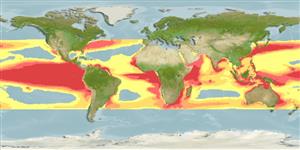Elasmobranchii (haaien en roggen) (sharks and rays) >
Myliobatiformes (Stingrays) >
Mobulidae (Devilrays)
Eponymy: Dr Edgar Thurston (1855–1935) was an ethnographer, natural historian and musicologist who qualified as a physician in England (1877). [...] (Ref. 128868), visit book page.
Environment: milieu / Klimaatzone / Diepte / distribution range
Ecologie
marien pelagic-oceanic; diepte 0 - 100 m (Ref. 12951). Subtropical; 38°N - 34°S
Circumglobal in tropical seas. Indian Ocean: off South Africa, Bay of Bengal, and probably Indonesia (Ref. 9911). Eastern Central Pacific: From Gulf of California to Chile (Ref. 130539).
Lengte bij maturiteit / Grootte / Gewicht / Leeftijd
Maturiteit: Lm 163.6, range 146 - ? cm
Max length : 220 cm WD mannelijk / geslacht onbekend; (Ref. 2850); common length : 150 cm WD mannelijk / geslacht onbekend; (Ref. 9256)
Korte beschrijving
Determinatiesleutels | Morfologie | Morfometrie
A moderate-sized devilray with a short head bearing short head fins; dorsal fin white-tipped, and pectoral fins with swept-back tips and a prominent double bend to the front margins; upper disc sparsely covered with small, blunt denticles and tail shorter than disc, with no spine (Ref. 5578). Dark blue to black above; white below, with silvery pectoral fin tips (Ref. 5578). No caudal fin (Ref. 5578).
Body shape (shape guide): other.
Occurs in coastal and oceanic waters, but more common near the coast (Ref. 9256). Found singly or in small groups (Ref. 12951). Feeds mainly on planktonic crustaceans (Ref. 12951); mostly small shrimp-like animals (Ref.58048). Ovoviviparous (Ref. 50449). Caught occasionally in the tuna gillnet and in harpoon fisheries. Utilized for its gill filter plates (high value), meat, cartilage and skin (Ref.58048). Can leap out of the water.
Exhibit ovoviparity (aplacental viviparity), with embryos feeding initially on yolk, then receiving additional nourishment from the mother by indirect absorption of uterine fluid enriched with mucus, fat or protein through specialised structures (Ref. 50449). With one large offspring per gestation period. Size at birth 65-85 cm (Ref. 6871).
Last, P.R. and J.D. Stevens, 1994. Sharks and rays of Australia. CSIRO, Australia. 513 p. (Ref. 6871)
Status op de Rode Lijst van het IUCN (Ref. 130435: Version 2025-1)
Gevaar voor de mens
Harmless
Gebruik door de mens
Visserij: van minder commercieel belang
Tools
Speciale rapporten
Download XML
Internetbronnen
Estimates based on models
Preferred temperature (Ref.
123201): 21.6 - 29.1, mean 27.8 °C (based on 2652 cells).
Fylogenetische diversiteitsindex (Ref.
82804): PD
50 = 0.5039 [Uniqueness, from 0.5 = low to 2.0 = high].
Bayesian length-weight: a=0.01000 (0.00244 - 0.04107), b=3.04 (2.81 - 3.27), in cm total length, based on all LWR estimates for this body shape (Ref.
93245).
Trofisch niveau (Ref.
69278): 3.1 ±0.30 se; based on food items.
Weerstandsvermogen (Ref.
120179): Zeer laag, minimale populatieverdubbelingstijd meer dan 14 jaar (Fec=1).
Fishing Vulnerability (Ref.
59153): Very high vulnerability (84 of 100).
🛈
Nutrients (Ref.
124155): Calcium = 7.99 [1.05, 135.60] mg/100g; Iron = 0.83 [0.08, 10.24] mg/100g; Protein = 20.6 [15.3, 25.9] %; Omega3 = 0.157 [0.047, 0.501] g/100g; Selenium = 22.8 [4.7, 120.5] μg/100g; VitaminA = 4.56 [0.35, 57.84] μg/100g; Zinc = 0.483 [0.030, 5.484] mg/100g (wet weight);
